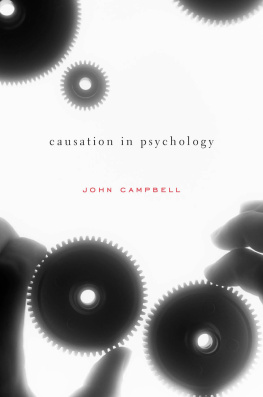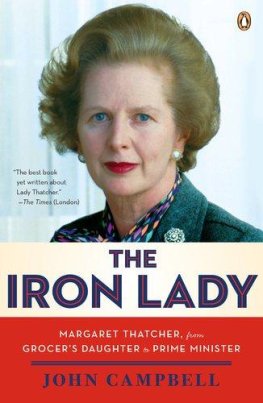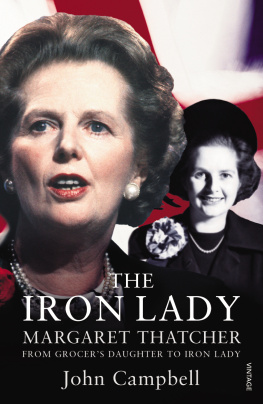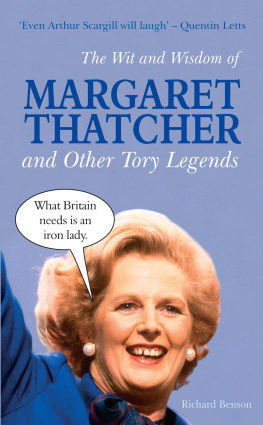Table of Contents
PENGUIN BOOKS
THE IRON LADY
John Campbell is one of the countrys leading political biographers. His books include Lloyd George: The Goat in the Wilderness , Edward Heath (for which he was awarded the NCR Award) and If Love Were All ... The Story of Frances Stevenson and David Lloyd George. His latest book is Pistols at Dawn: Two Hundred Years of Political Rivalry from Pitt and Fox to Blair and Brown .
David Freeman is Lecturer in History at California State University, Fullerton. He earned his Ph.D. in modern British history and serves on the staff of Finest Hour , the journal of the Churchill Centre to which he has contributed articles about Churchill and the Invention of Iraq, Churchill and the Anglo-Irish Treaty and Churchill & De Valera. He is working on a book about Leo Amery and Imperial Preference.
PENGUIN BOOKS
Published by the Penguin Group
Penguin Group (USA) Inc., 375 Hudson Street, New York, New York 10014, U.S.A.
Penguin Group (Canada), 90 Eglinton Avenue East, Suite 700, Toronto,
Ontario, Canada M4P 2Y3 (a division of Pearson Penguin Canada Inc.)
Penguin Books Ltd, 80 Strand, London WC2R 0RL, England
Penguin Ireland, 25 St Stephens Green, Dublin 2, Ireland (a division of Penguin Books Ltd)
Penguin Group (Australia), 250 Camberwell Road, Camberwell,
Victoria 3124, Australia (a division of Pearson Australia Group Pty Ltd)
Penguin Books India Pvt Ltd, 11 Community Centre, Panchsheel Park, New Delhi 110 017, India
Penguin Group (NZ), 67 Apollo Drive, Rosedale, Auckland 0632,
New Zealand (a division of Pearson New Zealand Ltd)
Penguin Books (South Africa) (Pty) Ltd, 24 Sturdee Avenue,
Rosebank, Johannesburg 2196, South Africa
Penguin Books Ltd, Registered Offices:
80 Strand, London WC2R 0RL, England
First published in Great Britain by Vintage,
a division of Random House Group Ltd. (UK) 2009
Published in Penguin Books (USA) 2011
Revised edition copyright John Campbell, 2009
Abridgement copyright David Freeman, 2009
All rights reserved
ISBN : 978-1-101-55866-9
CIP data available
The scanning, uploading, and distribution of this book via the Internet or via any other means without the permission of the publisher is illegal and punishable by law. Please purchase only authorized electronic editions, and do not participate in or encourage electronic piracy of copyrighted materials. Your support of the authors rights is appreciated.
http://us.penguingroup.com
For Robin and Paddy two of Thatchers children
Acknowledgements
T HIS book was originally published in two volumes totalling more than 1,200 pages.The present volume is drastically reduced to make it more accessible to the general reader. Inevitably much of the detail and some of the colour of the original have been sacrificed. But I hope that the integrity of the book has been preserved. I am immensely grateful to David Freeman of the University of California for carrying out the work of abridgement so skilfully. I could not have done it myself, but I think he has done a superb job. If there is now a somewhat greater emphasis on foreign relations and the major enduring themes of Lady Thatchers life and rather less on her early life and the small change of party politics, I think that is appropriate as her career moves into a longer historical perspective. It is now 30 years since she came to power and 19 since she fell. In that time the world has continued to evolve: some of the hopes raised by the ending of the Cold War have not been realised, while Islamist terrorism, climate change and now a global financial crisis pose new problems scarcely imagined in her day. Beyond a very brief contemporary conclusion to the last chapter, however, I have not attempted to rewrite the original book. Remarkably little new information has emerged which requires substantial reinterpretation or revision. Most of the assumptions and judgments I made in 2000 and 2003, I believe, still stand. They are themselves part of the record of the time. For two decades after her fall Margaret Thatcher continued to exercise a powerful grip on the imagination of the country and of her successors. But already a new generation is growing up who scarcely remember her. I hope that this book, in its shortened form, may serve as a useful introduction to them, as well as a reminder to those who lived through the high drama of what will always be the Thatcher years. Those whose appetite is whetted may wish to go back to the original volumes for more detail.
I incurred an immense number of debts during the nine years it took me to write this book: scores of interviews, dozens of more casual conversations, many valuable pointers from friends and colleagues, much help from librarians and archivists. But I made due acknowledgement for all this help in the original volumes, and I hope it will be understood if I do not repeat my thanks in detail here: most of the interviewees are credited in the notes. I do, however, need to thank again HarperCollins, for allowing me to use substantial quotation from Lady Thatchers memoirs and also from Carol Thatchers biography of her father; Macmillan for allowing me to quote from Woodrow Wyatts diaries; David Higham Associates for permission to quote from Barbara Castles diaries; and Brook Associates for allowing me to quote from interviews for their television series The Seventies and The Thatcher Factor. I confess that I have not sought specific permission for every quotation I have made from the many other memoirs and diaries of the period but I am grateful to all those authors who put their memories into the public realm. I am also grateful to the United States Government for allowing access to and quotation from the papers of Presidents Carter, Reagan and Bush under the Freedom of Information Act, and to the staff of the three presidential libraries who guided me to what I needed to see on a necessarily short visit to the States in 2001. Finally I should like to thank again my publishers Dan Franklin at Jonathan Cape for the original volumes and now Alison Hennessey at Vintage for handling the abridgement; my agent Bruce Hunter; my children Robin and Paddy; and finally, for her love, faith and companionship over the past five years, Kirsty Hogarth. To all of them my debt is incalculable.
John Campbell
December 2008
Dutiful Daughter
Grantham born
A FORMER town clerk once described Grantham as a narrow town, built on a narrow street and inhabited by narrow people. Yet Grantham was once more than this. Look closer and it is a palimpsest of English history. Incorporated in 1463, it was a medieval market town. Kings stopped there on their journeys north: Richard III signed Buckinghams death warrant in the Angel Hotel. St Wulframs church boasts one of the tallest spires in England. Englands greatest scientist, Isaac Newton, was born seven miles south of the town in 1642 and educated at the grammar school.
Beatrice Stephenson Margaret Thatchers mother was Grantham born and bred. She was born on 24 August 1888. Her father, Daniel Stephenson, is euphemistically described as a railwayman: he was actually for thirty-five years a cloakroom attendant. He married, in 1876, Phoebe Crust, described as a farmers daughter (which might mean anything) from the village of Fishtoft Fen, near Boston, who had found work in Grantham as a factory machinist. Beatrice, one of several children, lived at home in South Parade until she was twenty-eight, working as a seamstress. Her daughter says she had her own business; but whether she worked alone or employed other girls there is no record. In December 1916 Daniel died. Five months later, on 28 May 1917, Beatrice married an ambitious young shop assistant four years younger than herself whom she had met at chapel: Alfred Roberts.

















